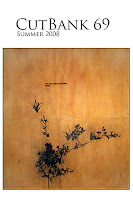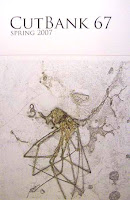
Factory School, 2006
Reviewed by Erica Kaufman
To open a book called obedience, the reader is immediately faced with the question of obedience to what. Though to open kari edwards’ fourth collection is to discover that there is nothing “obedient” about this text. Even the epigraph by Judith Butler that begins the book, “Possibility is not a luxury; it is crucial as bread,” indicates an emphasis on variance, rather than stagnancy. In other words, here is a book that is interested in the opening up of language and situations, as opposed to the typical and easier obeyance, or subordination.
The book opens with the word “let’s,” the conjunction for “let us.” This phrase indicates not only a certain permission or opportunity, but also foreshadows a “release,” in this case that of “a body covered in leaves/not the imagined/here to cure this language plague” (38). Right from the start, edwards sets the stage for the unpredictable, she mixes familiar words with jargon, beginning a litany that circles and undoes itself, as if to literally deconstruct the climate one lives in.
this is your base (a square hole)
this is your weapon (a condition)
therefore
I am you
a fill-in-the-blank (perception)
which is nothing more than masturbation
part memory
part blood soaked sheets
part remastered destiny (7)
The parenthetic asides act as commentary or snipes at words preceding them. What further empowers this opening verse is the direct phrasing of the lines themselves. This text is assertive, and through this wise use of the imperative, it is virtually impossible to turn a page without reading every single word. And, this carries even more meaning because there is little truth in so much of what surrounds us (meaning the general public).
sometimes there’s qualities in schema
sometimes things like things, cut matter (8)
*
In “The Author as Producer,” Walter Benjamin writes, “[The writer] directs his activity towards what will be useful to the proletariat in the class struggle. This is usually called pursuing a tendency, or ‘commitment.’” In the exploration of “naming” alongside a multi-genre book-length work, edwards succeeds in grounding the reader in an alternative society,
depending on the country
and proper name
given by the institute that names names
names the damned (13)
This is a space where the non-verbal, overlooked problems in society are verbalized as a litany, an intense, short-lined, 39-page invocation that itemizes what one is afraid to face, “the we/who have not been murdered” (29). In this crystalline language, edwards takes on cultural nomenclature or the lack thereof. She masterfully melds the vocabulary of commodity and capitalism with an exposition and deconstruction of the singular, pronouns, and the often impossibility of a stable public identity.
pronouns are lost and then found
or never invented or intended
and we all play safe
with stick familiar (9)
Returning to the idea of “tendency,” edwards questions the very notion of parts of speech so embedded in cultural expression that one barely stops to think about their usage. But the point is that we need to stop, to think in detail about the words we use or allow ourselves to use as labels, as blanket phrases. No terminology is safe, nor should it be safe.
a vital impression
that accepts plastic
what do i know?
everyone doubts doubt
doubts bodies
criticized at inception (20)
In Masculine/Feminine or Human? Janet Saltzman Chafetz writes, “Human beings try to make sense out of their own world by lumping together a variety of individual cases, labeling them, and then reacting to categories of phenomena.” What edwards accomplishes is the recognition of the individual, the necessary acknowledgement of biological and political restraints that keep human hands tied, minds frozen. she is a writer I endlessly admire, increasingly so with each volume I read. What is accomplished in the first half of obedience is a large-scale mediation between questioning and assertions of perhaps a majority of societal claims and problems that have never really been addressed before.
i have been deprived of a name
kept quiet in a place
called eventually (30)
*
“because,” (40) appears alone on a page, signifying a foreshadowing of a shift in form, or perhaps an entrance into another movement or body of words. “Because” is a conjunction, meaning that we are accustomed to seeing it as the center part of a sentence, a word that indicates an explanation will follow. The effect of placing this word alone on a page, accompanied only by a comma, is one of both space and tension. It gives the reader a break from the intensity of the litany of the first 39 pages of the book, but at the same time leaves the mind anticipating what will come next. It is, essentially, the perfect transitional tactic.
The reader now enters into a textual space where form becomes transitory and many of the direct statements listed in the first half of the book are now expanded upon.
because there is no apparent singular
couched in a connection between
sensible and secret powers (41)
“Because” begins as a vessel to peer into the negative, as in “no apparent.” However, the word choices do not indicate this negative to be all-encompassing. A “singular” is displayed, as are words such as “sensible” and “secret.” This word transmutation is reminiscent of Acker’s statement in “Against Ordinary Language: The Language of the Body,” that “the physical or material, that which is, is constantly and unpredictably changing: it is chaotic.” And, there is chaos here, but an effective chaos, one that takes the reader (or viewer) on a journey through sprawling language that mediates back and forth between prose, projective verse, and the left-justified short-lined form of the first half of the book.
no fixed logic
no fixed conception
no fixed bias
neither female nor male (43)
Similar to the phrase “no fixed,” as this section progresses little is fixed, not even the situating of the words themselves. The effect of this is the feeling that the left justified statements of the early parts of the poems have morphed into a sort of answer that undoes the very form or appearance of the charges or questions previously defined. There truly is “no fixed logic,” especially in a social space where so much depends on forced or inherently learned societal stigmas. And, the text itself visually echoes this.
may the day be speaking of speaking, the sanctuary, of humanity
and illumination in the flower of clarity, speaking of the
poor and hungry breath of the ocean, of the saliva, of saints
in the dust at the end of the day, at the end of all bigotry (48)
Once edwards’ lines begin to sprawl, so does the scope of the relations of the text. The reader finds almost direct addresses (or “commitments”) to “the poor and hungry” or “at the end of all bigotry.” This is a writer whose head and heart is in all the right places. While activism and politics are at the forefront of many of our minds, it is hard to find the most effective angle when critiquing the perpetually disturbing hegemony we live under. But, edwards finds again and again the most successful ways of doing so. S/he elides the problem of hegemony with her syntactical revolutions, fluid prosaic lyricism, and perhaps most importantly, unabashed, semantically brilliant honesty.
this could be a series of singulars busting forth, points of grand realignment, instantaneous realignment, bringing life to the mud and the slime, entertaining a continuum in something multiple, segments and singularities (53)
Here we see an empowering passage of “singulars,” of “realignment.” In contrast to words like “lost” and “deprived” (both found in the first half of the book), the word choice in these few lines alone indicates a sort of reconciliation, or a coming to terms with what needs to be done, “a dark unimpressed otherwise—stripped bare in a memory of a/memory, always waiting for someone to speak and being spoken to…” (55). As the text expands, so does the exposition of the “other.” And this exposition of the reality of the “other” turns to the memory of another.
I keep listening for what they think
but I can’t enter their lurid regime
leaving me out and without
saying writing, writing saying
this other hand
named and pointed to
shown the invisible (58)
No matter what shape the words or lines take, no matter how hard one tries to hear, obedience is not an option (“I can’t enter their lurid regime”). This stance is one that radiates courage because it is easier to submit (or submerge) than to cope with the feeling of being “left out.”
almost silence, but stranger still
a pursuit of this or that
such that the world will change (60)
What needs to happen to create change? This answer is not named; it has no name, no body, only pronouns and adverbs. No solution is offered, only strength in language. When one strips hegemonic oppression down, what is left but linguistic strength, the ability to verbalize what is wrong (“-watching a word watch itself-“ (62)).
In order to cement the circularity of continuous societal restraints, obedience ends where it begins, with “let’s begin again” (82). Every page leading up to this has presented language and assertions that undo themselves every step of the way, mostly as a means to present the reality of the scope of identity, body, and cultural problematizing that happens daily. And, this phrase appears on a page alone, indicating a pause, or a space to fill.
if in fact
it is a place in time
turning back on itself
holding both and merely in an intention (80)
*
Julia Kristeva refers to literature as “work at shedding light on the laws of this immemorable language, this unconscious algebra that traverses discourse, this basic logic that establishes relations.” edwards is a writer who expands this “immemorable language” to extraordinary lengths. s/he not only “traverses discourse,” but overcomes and reinvents it. Every time I read a book by edwards, I am not only awed by her command of form (cross-genre mastery), but also with the ground she covers in the rather short space of a poetry book (82 pages). obedience is certainly another edwards must read, simultaneously beautiful and alarming, hypnotic and awakening, bodily and true.
**
kari edwards, a poet, artist and gender activist, received one of Small Press Traffic's books of the year awards (2004), New Langton Art's Bay Area Award in literature (2002); and is author of obedience, Factory School (2005); iduna, O Books (2003), a day in the life of p., subpress collective (2002), a diary of lies - Belladonna #27 by Belladonna Books (2002), and ost/(pink) Scarlet Press (2000).
**
erica kaufman co-curates the belladonna* reading series and small press. she is the author of several chapbooks including a familiar album (which won the 2003 New School University Chapbook Contest). her work can be found or is forthcoming in jubilat, puppy flowers, CARVE, LIT, The Mississippi Review, Bombay Gin, among other places. erica lives in Brooklyn.



